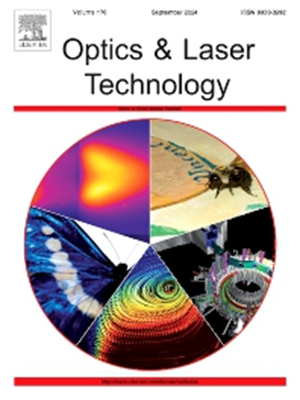Theoretical study on modulation of filamentation patterns by crystal orientation and polarization structure
IF 4.6
2区 物理与天体物理
Q1 OPTICS
引用次数: 0
Abstract
The anisotropic Kerr media with complex structure offers a new paradigm to forming diverse filamentation patterns. A great challenge and expectation is to flexibly modulate the distribution of filaments. Herein, we propose and demonstrate that controllable filamentation patterns in cubic crystals can be achieved by the synergy of crystal orientation and polarization structure. The results reveal that the self-focusing patterns exhibit high symmetry when the vector optical fields (VOFs) are incident along the crystal’s principal axis. Interestingly, once the incident orientation is changed, the filament intervals will be unevenly distributed. Additionally, the synergy of crystal orientation and polarization structure actively breaks the symmetry, making the resulting collapse patterns nearly immune to the extra random noise. Finally, we derive the analytical solution for the positions of the filaments and elucidate the underlying physical mechanisms. The findings may have potential in micro–nano fabrication, wave-guides, and other related applications.
求助全文
约1分钟内获得全文
求助全文
来源期刊
CiteScore
8.50
自引率
10.00%
发文量
1060
审稿时长
3.4 months
期刊介绍:
Optics & Laser Technology aims to provide a vehicle for the publication of a broad range of high quality research and review papers in those fields of scientific and engineering research appertaining to the development and application of the technology of optics and lasers. Papers describing original work in these areas are submitted to rigorous refereeing prior to acceptance for publication.
The scope of Optics & Laser Technology encompasses, but is not restricted to, the following areas:
•development in all types of lasers
•developments in optoelectronic devices and photonics
•developments in new photonics and optical concepts
•developments in conventional optics, optical instruments and components
•techniques of optical metrology, including interferometry and optical fibre sensors
•LIDAR and other non-contact optical measurement techniques, including optical methods in heat and fluid flow
•applications of lasers to materials processing, optical NDT display (including holography) and optical communication
•research and development in the field of laser safety including studies of hazards resulting from the applications of lasers (laser safety, hazards of laser fume)
•developments in optical computing and optical information processing
•developments in new optical materials
•developments in new optical characterization methods and techniques
•developments in quantum optics
•developments in light assisted micro and nanofabrication methods and techniques
•developments in nanophotonics and biophotonics
•developments in imaging processing and systems

 求助内容:
求助内容: 应助结果提醒方式:
应助结果提醒方式:


